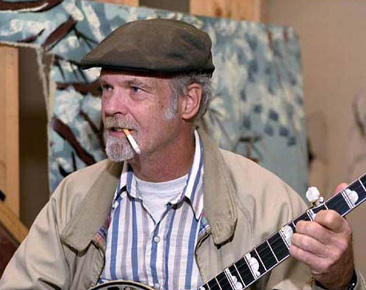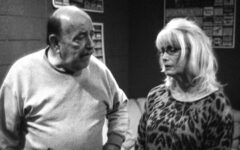
 As previously noted, banjo innovator Bill Keith passed away on Friday, October 23, 2015. He was 75 years old and had been in poor health for some time. We recall his sterling career in this retrospective.
As previously noted, banjo innovator Bill Keith passed away on Friday, October 23, 2015. He was 75 years old and had been in poor health for some time. We recall his sterling career in this retrospective.
William Bradford Keith was born on December 20, 1939, in Boston, Massachusetts, and developed a flexible, scalar style of banjo playing that was ideal for playing the melody of fiddle tunes note for note.
He grew up in Brockton (near Boston) and attended Phillips Exeter Academy and Amherst College, where he studied French literature, graduating in 1961.
As far as music is concerned, Keith studied ukulele and piano as a child and then he became interested in the banjo, firstly the tenor version of the instrument, at the age of 12 years. While at junior high and prep schools he played in various Dixieland bands.
While at college he studied the banjo recordings of Earl Scruggs, Don Reno and other prominent bluegrass banjo players of the day. One of those was Don Stover, who played regularly with the Lilly Brothers at a venue (Club 47) that Keith was to get to know well. He played many shows there with those and other talented musicians from New England.
Keith became interested in folk music while in college, a curiosity led him to the five-string banjo and to Pete Seeger’s seminal instructional book, How to Play the Five-String Banjo.
He began experimenting, trying to create his own distinctive sounds on the banjo. With the help of a fiddle-playing neighbor, June Hall, Keith succeeded in developing a three-finger technique that mimicked the Scruggs approach in that it employed different fingers of the right hand for each consecutive note, but in patterns which, when combined with newly-developed left hand fingerings, could recreate complex fiddle melodies.
While at Amherst, he met fellow musician (and later author) Jim Rooney; the duo were college room-mates. They would jam together and play on campus, in local coffee-houses and on radio shows and opened a show for Joan Baez. Also, they were co-founders, with promoter Manny Greenhill, of the Connecticut Folklore Society.
The two would play together and in various bands over the next few decades.
In 1961 he moved to Washington D.C. met Red Allen and Frank Wakefield and briefly he joined the Kentuckians, recording on six tracks for their eponymous Folkways album FA 2408.
Back with Rooney (1962) they formed a band that also included Joe Val and Herb Applin and they released an album, Livin’ On the Mountain, for Prestige/Folklore.
Through Greenhill, banjo master Earl Scruggs met and invited Keith to Nashville to assist in writing the tablature for Scruggs’ own instruction book, Earl Scruggs and the 5-String Banjo. In addition, Keith was pivotal in developing the pitch-changing device that became known as the Scruggs tuner. Scruggs used the effect on songs such as Flint Hill Special and Randy Lynn Rag.
When Bill Monroe heard Keith playing the old fiddle tune The Devil’s Dream backstage at the Grand Ole Opry in early 1963, he immediately offered him a job in his band.
Monroe thought very highly of his playing so much so that he arranged for an early recording session to capture his playing on vinyl. On March 20, 1963, Keith recorded three instrumentals; Salt Creek, Devil’s Dream and Sailor’s Hornpipe. The first two were released as singles. A week later Keith recorded three more instrumentals; Pike County Breakdown, Shenandoah Breakdown (another track released as a single) and Santa Claus.
Although Keith wasn’t involved in any other recording sessions, he can nowadays be heard playing at the Ash Grove in Los Angeles, the Monterey Folk Festival, Monterey, Rhode Island, Newport Folk Festival, Newport, Rhode Island, and The Mechanics Hall, Worcester, Massachusetts, where he was captured ‘live’.
Monroe overcame the problem of the confusion of having two Bills in the band by always introducing Keith as “Brad,” a shortening of his middle name, Bradford.
On leaving the Blue Grass Boys, Keith turned his attention to doing some session work.
In 1964 he joined the legendary Jim Kweskin Jug Band, playing plectrum banjo. He stayed for four years with Kweskin.
After that he played and recorded as part of the Blue Velvet Band (Keith, Jim Rooney, Eric Weissberg and Richard Greene). He abandoned the banjo for a while when, in 1968, he became a pedal steel guitarist with Ian and Sylvia.
Keith moved to Woodstock, New York, in 1970 and did a year-long tour of duty with Jonathan Edwards before going to work with Judy Collins, recording with both.
 For the 1970s and 1980s Keith teamed up with Jim Rooney and as well playing dates in USA the duo toured throughout Europe, with Keith becoming extremely popular in France, no doubt aided by his love of 18th-century French literature and a fluency in contemporary French conversation.
For the 1970s and 1980s Keith teamed up with Jim Rooney and as well playing dates in USA the duo toured throughout Europe, with Keith becoming extremely popular in France, no doubt aided by his love of 18th-century French literature and a fluency in contemporary French conversation.
During the 1970s and 1980s Keith also recorded a few times for Rounder Records, having solo releases (Something Auld, Something New, Something Borrowed, and Something Bluegrass and Banjoistics); as well as albums in collaboration with Tony Trischka and Bela Fleck (Fiddle Tunes for Banjo).
Keith and fellow Woodstock musicians would play together regularly and he became the banjo player in what loosely evolved into the Woodstock Mountain Review.
Continuing his musical meanderings he collaborated with Peter Rowan, David Grisman and Clarence White, collectively as part of Muleskinner (1973); released a Rounder album One Day at a Time (with Rooney)(1975); in May of that same year Keith toured Japan as part of the Bluegrass Quintet (David Grisman, Tony Rice, Todd Phillips, Richard Greene and Bill Keith); helped to record the David Grisman Rounder Album; in 1977 he worked briefly as a columnist, writing about music theory, for Frets magazine; in 1985 he worked on Peter Rowan’s The First Whippoorwill; in 1989, Keith, Rooney, Eric Weissberg and Kenny Koseck re-formed their old group, now calling it the New Blue Velvet Band; assisted in the recording of Richard Greene’s The Grass Is Greener (released in April 1995); assisted in the recording of Frank Wakefield’s Don’t Lie To Me (released in 2003); appeared on Beausoleil’s Alligator Purse album, released in 2009; and he issued instructional booklets with accompanying CD/DVDs.
 Keith was not only an innovative banjo player and an influence on newgrass and Dawg music, he was a significant contributor to the improvement of banjo hardware.
Keith was not only an innovative banjo player and an influence on newgrass and Dawg music, he was a significant contributor to the improvement of banjo hardware.
It all began in 1961 when he moved to Washington D.C. to learn banjo-making techniques under Tom Morgan. It continued two years later with Dan Bump, when they worked on the development of a new banjo tuner that was superior to the Scruggs peg. It incorporated a pitch changer that actually replaced the existing pegs, rather than having a hole drilled and cams inserted for two additional pegs.
These new tuners devised a mechanism that allowed the player to set a high and low pitch point beyond which the peg would not turn, based on small, locking screws built into the design. Scruggs had made his famous recordings with cam-style tuners, but many owners of fine banjos blanched at the notion of drilling new holes in their headstocks.
In January 1964 Keith and Bump established Beacon Banjo Company; Keith was elected President. Earl Scruggs became a shareholder and the tuners were advertised as ‘Scruggs-Keith Tuners.’ However, ‘Scruggs-Keith-Bump’ was the impression that was stamped on the tuners.
Around 1970 when Scruggs sold his shares back to the company, and the embossment was changed to the ‘Keith Banjo Tuner’.
 Bill had reported being disappointed in his business dealings with Scruggs, feeling himself poorly served in the relationship. He was deeply affected by his musical hero treating him so shabbily, and he rarely held back from sharing his opinion on the topic later in his life. It also irritated him that the tuners he designed continued to be known generically as “Scruggs tuners.”
Bill had reported being disappointed in his business dealings with Scruggs, feeling himself poorly served in the relationship. He was deeply affected by his musical hero treating him so shabbily, and he rarely held back from sharing his opinion on the topic later in his life. It also irritated him that the tuners he designed continued to be known generically as “Scruggs tuners.”
Initially, tuner sales came from word-of-mouth recommendations. Later sales were boosted by an advert in Sing Out! magazine.
Over time sales were maintained at just below the initial peak, although a fall in sales in the late 1980s led to Keith becoming the sole owner. In a July 2000 interview Keith reckoned that he had sold over 30,000 pairs of tuners altogether.
During the over 50 years of business Beacon Banjo Company has had workshops in Cambridge, Massachusetts, Newburyport, Massachusetts, Putney, Vermont, and from his home in Woodstock, New York, where the business remains in the hands of Keith’s son Martin.
![]() It would be difficult to overstate the importance of his Keith tuner among banjo players in preserving the playing of the tunes that Scruggs wrote for them. Keith used them famously in his own recordings as well, as have many other celebrated players like John Hartford and Béla Fleck.
It would be difficult to overstate the importance of his Keith tuner among banjo players in preserving the playing of the tunes that Scruggs wrote for them. Keith used them famously in his own recordings as well, as have many other celebrated players like John Hartford and Béla Fleck.
Beacon also developed a top drawer standard banjo tuning peg which they market online and through dealers.
As well as being personally involved in the manufacturing and marketing process at Beacon Banjo Company, Keith also taught students in Woodstock and locations in New England and as far afield as Alan Munde and Joe Carr’s Bluegrass Camp at South Plains College in Levelland, Texas.
Monroe may have called him “Brad”, but it is the name of Bill Keith that we will remembered for the revolutionary style that he brought to banjo playing the left a great impression on not only bluegrass, but jazz and folk music as well.
Please also see the second part of this memorial, which includes the remembrances of several of Bill’s fellow banjo players.







